The Sphinx’s Riddle Explained: Analyzing Its Significance
I. Introduction
The Great Sphinx of Giza, an enigmatic limestone statue with the body of a lion and the head of a pharaoh, stands as one of the most iconic symbols of ancient Egyptian civilization. Dating back to around 2500 BCE, it has witnessed the rise and fall of empires, serving as a guardian of the Giza Plateau. But beyond its majestic presence, the Sphinx is also renowned for its riddle, which plays a pivotal role in mythology.
This article delves into the significance of the Sphinx’s riddle, exploring its origins, meanings, and its impact on literature and culture throughout history. As we unravel the layers of this ancient enigma, we aim to understand its relevance in both the past and present.
II. The Origins of the Sphinx and Its Riddle
The Sphinx is steeped in the history of ancient Egypt, symbolizing strength, wisdom, and protection. Traditionally believed to represent pharaohs, it served as a monumental guardian for the tombs of the kings. The Sphinx’s riddle is rooted in Greek mythology, particularly in the story of Oedipus.
According to myth, the Sphinx terrorized the city of Thebes, posing a riddle to travelers and devouring those who could not solve it. The riddle became a symbol of knowledge and the struggle for understanding.
The connection between the Sphinx and Oedipus is profound, as Oedipus is the only one who successfully solves the riddle, leading to both his triumph and his tragic downfall.
III. The Riddle of the Sphinx: Text and Meaning
The riddle presented by the Sphinx is as follows: “What walks on four legs in the morning, two legs at noon, and three legs in the evening?”
Breaking down the riddle’s components:
- Morning: Represents infancy, when a human crawls on all fours.
- Noon: Symbolizes adulthood, when a human walks on two legs.
- Evening: Reflects old age, when a human may use a cane, thus walking on three legs.
This interpretation highlights the stages of human life, emphasizing the transient nature of existence and the inevitability of aging and mortality.
IV. Symbolism and Themes in the Riddle
The riddle encapsulates profound themes of time, life, and mortality. It is a meditation on the human condition, inviting reflection on the passage of time and the various stages of life.
The Sphinx itself serves as a symbol of knowledge and mystery, embodying the quest for understanding and the challenges that accompany it. The riddle reflects the complexities of human existence, posing questions about identity, purpose, and mortality.
V. The Riddle’s Role in the Story of Oedipus
Oedipus’s encounter with the Sphinx occurs during his journey to Thebes, where he is confronted by the creature. The context of this encounter is crucial, as Oedipus is seeking to rid the city of its plague, which the Sphinx’s riddle perpetuates.
Solving the riddle is monumental for Oedipus, as it not only saves him from the Sphinx but also sets in motion the events that will ultimately determine his tragic destiny. The resolution of the riddle leads to Oedipus becoming the king of Thebes, but it also foreshadows his eventual downfall, rooted in fate and self-discovery.
VI. Cultural Impact and Interpretations
The Sphinx’s riddle has resonated through literature and art for centuries, inspiring countless interpretations and adaptations. It appears in various forms across cultures, often symbolizing the pursuit of knowledge and the trials one must face.
In modern times, the riddle has influenced philosophical thought, prompting discussions on existentialism and the nature of human life. It challenges individuals to contemplate their existence and the passage of time, leading to a deeper understanding of life’s complexities.
VII. The Riddle’s Legacy in Contemporary Society
Even today, the Sphinx’s riddle remains relevant. Its themes of growth, change, and the quest for knowledge resonate with contemporary audiences. The enduring fascination with riddles and puzzles speaks to a universal human desire for understanding and clarity.
Lessons learned from the Sphinx’s riddle can be applied in modern life:
- Embrace the journey of life, recognizing the value in each stage.
- Seek knowledge and understanding in the face of challenges.
- Reflect on the passage of time and how it shapes our identities.
VIII. Conclusion
In summary, the Sphinx’s riddle is a significant element of ancient mythology that continues to captivate and inspire. Its exploration of human existence, time, and mortality offers profound insights that transcend time and culture.
Understanding such myths enriches our perspective on life and the human experience. We invite readers to delve deeper into ancient myths and explore their meanings, as they hold timeless lessons that remain impactful in today’s world.




